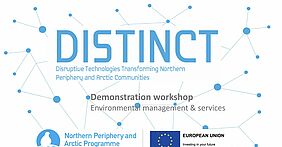Hosted by project partners in Umeå University (Sweden), DISTINCT project partners have organised the first of the series of the DISTINCT Disruptive Tuesdays, that focus on the application of disruptive technologies -Virtual Reality (VR), Internet of Things (IoT) and Artificial Intelligence (AI)- in environmental management.
The first speaker, Mr. Johan Vesslén from CGI Sweden AB, explained the application of Augmented Reality (AR) and Virtual Reality (VR) to visualize underground infrastructures through a real example: Hidden City. He presented Kiruna, a town in the northern most part of Sweden that sits directly atop one of the world’s largest iron ore deposits. For many years, the mine near the city helped the town flourish. However, as the mine expanded and digging went deeper, the removal of ore started to head in the direction of the city. As a result, the Swedish government developed a plan to move the entire town 3.2 kilometers to the east. During the initial phases of the Kiruna relocation, a Computer-Generated Imagery (CGI) expert from Kiruna devised an innovative concept called Hidden City that uses Microsoft HoloLens Augmented Reality in combination with Geographic Information System (GIS) equipment and data to digitally map and visualize the underground infrastructure. Vesslén mentioned that the project is pioneering the outdoor use of HoloLens, which by design, is made to be used indoors.
The second speaker presented a pilot project developed by Derry City and Strabane District Council (Northern Ireland) within the Northern Periphery and Arctic Programme funded EMERGREEN project. Mr. Agustin Garcia Pereira, from National University of Ireland - Galway, showcased an example of Artificial Intelligence (AI)-powered conversational chatbots for greener services to change public behaviour towards achieving a zerowaste circular district in Derry and Strabane. According to him, this service uses chatbot technologies providing an online response service on information regarding waste, bin collecting, recycling services, etc. 24 hours a day 7 days a week. It is also aimed at helping people report issues more easily and freeing council staff from dealing with mundane enquiries concentrating instead on more complex questions.
The last but not least topic of the session referred to Internet of Things (IoT) application for water management, a Smart Sewer system. Mr. Fredrik Sahl, from Flow Below AB, presented the Vakin company, which is owned by Umeå municipality (Sweden) and takes care of services such as water delivery and the sewer system for the inhabitants of Umeå. Occasionally pipes break down, and often, this results in hours spent to find leak and repair it. Vakin’s solution to this problem is that they have set up a project together with the company Flow Below in which they have placed around 180 sensors measuring leakage in the sewer system in one city district in Umeå. The sensors are wired to the LoRa-net which means that Vakin can monitor data continuously from the sewer system in real-time.
An open discussion took place where attendees could reflect on the challenges and opportunities that these technologies bring in the management of environment by public sector. Some collaboration ideas also emerged from the discussion.
Stay tuned! DISTINCT project partners will organise two more sessions:
- On the 7th of December 2021, Use of Disruptive Technologies in health and social care
- On the 25th of January 2022, Use of Disruptive Technologies in education and training

